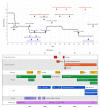Web-Based Graphic Representation of the Life Course of Mental Health: Cross-Sectional Study Across the Spectrum of Mood, Anxiety, Eating, and Substance Use Disorders
- PMID: 32012081
- PMCID: PMC7013650
- DOI: 10.2196/16919
Web-Based Graphic Representation of the Life Course of Mental Health: Cross-Sectional Study Across the Spectrum of Mood, Anxiety, Eating, and Substance Use Disorders
Abstract
Background: Although patient history is essential for informing mental health assessment, diagnosis, and prognosis, there is a dearth of standardized instruments measuring time-dependent factors relevant to psychiatric disorders. Previous research has demonstrated the potential utility of graphical representations, termed life charts, for depicting the complexity of the course of mental illness. However, the implementation of these assessments is limited by the exclusive focus on specific mental illnesses (ie, bipolar disorder) and the lack of intuitive graphical interfaces for data collection and visualization.
Objective: This study aimed to develop and test the utility of the Tulsa Life Chart (TLC) as a Web-based, structured approach for obtaining and graphically representing historical information on psychosocial and mental health events relevant across a spectrum of psychiatric disorders.
Methods: The TLC interview was completed at baseline by 499 participants of the Tulsa 1000, a longitudinal study of individuals with depressive, anxiety, substance use, or eating disorders and healthy comparisons (HCs). All data were entered electronically, and a 1-page electronic and interactive graphical representation was developed using the Google Visualization Application Programming Interface. For 8 distinct life epochs (periods of approximately 5-10 years), the TLC assessed the following factors: school attendance, hobbies, jobs, social support, substance use, mental health treatment, family structure changes, negative and positive events, and epoch and event-related mood ratings. We used generalized linear mixed models (GLMMs) to evaluate trajectories of each domain over time and by sex, age, and diagnosis, using case examples and Web-based interactive graphs to visualize data.
Results: GLMM analyses revealed main or interaction effects of epoch and diagnosis for all domains. Epoch by diagnosis interactions were identified for mood ratings and the number of negative-versus-positive events (all P values <.001), with all psychiatric groups reporting worse mood and greater negative-versus-positive events than HCs. These differences were most robust at different epochs, depending on diagnosis. There were also diagnosis and epoch main effects for substance use, mental health treatment received, social support, and hobbies (P<.001). User experience ratings (each on a 1-5 scale) revealed that participants found the TLC pleasant to complete (mean 3.07, SD 1.26) and useful for understanding their mental health (mean 3.07, SD 1.26), and that they were likely to recommend it to others (mean 3.42, SD 0.85).
Conclusions: The TLC provides a structured, Web-based transdiagnostic assessment of psychosocial history relevant for the diagnosis and treatment of psychiatric disorders. Interactive, 1-page graphical representations of the TLC allow for the efficient communication of historical life information that would be useful for clinicians, patients, and family members.
Keywords: anxiety; depression; eating disorders; life history; mental health; psychosocial factors; substance use disorders.
©Robin Leora Aupperle, Martin P Paulus, Rayus Kuplicki, James Touthang, Teresa Victor, Hung-Wen Yeh, Tulsa 1000 Investigators Tulsa 1000 Investigators, Sahib S Khalsa. Originally published in JMIR Mental Health (http://mental.jmir.org), 28.01.2020.
Conflict of interest statement
Conflicts of Interest: RA reports grants from the NIMH, the National Institute of General Medical Sciences, and the Oklahoma Science and Technology Research and Development. MP is an advisor to Spring Care, Inc, a behavioral health startup; he has received royalties for a paper about methamphetamine in UpToDate and also has received support from the National Institute of General Medical Sciences. MP, RK, JB, YC, HY, JF, and JS report receiving support from the National Institute of General Medical Sciences. JT and TV report no competing interests or outside support. JS received support from the NIMH and the National Institute of General Medical Sciences. SK reports grants from the NIMH, the National Institute of General Medical Sciences, and the Intra-Cellular Therapies Inc. The copyright for the TLC is owned by LIBR (Registration TXu002163895).
Figures




References
-
- Manderscheid RW, Ryff CD, Freeman EJ, McKnight-Eily LR, Dhingra S, Strine TW. Evolving definitions of mental illness and wellness. Prev Chronic Dis. 2010 Jan;7(1):A19. https://www.cdc.gov/pcd/issues/2010/Jan/09_0124.htm - PMC - PubMed
-
- Kendler KS. Explanatory models for psychiatric illness. Am J Psychiatry. 2008 Jun;165(6):695–702. doi: 10.1176/appi.ajp.2008.07071061. http://europepmc.org/abstract/MED/18483135 - DOI - PMC - PubMed
-
- Fava GA, Sonino N. The biopsychosocial model thirty years later. Psychother Psychosom. 2008;77(1):1–2. doi: 10.1159/000110052. https://www.karger.com?DOI=10.1159/000110052 - DOI - PubMed
-
- Meyer GJ, Finn SE, Eyde LD, Kay GG, Moreland KL, Dies RR, Eisman EJ, Kubiszyn TW, Reed GM. Psychological testing and psychological assessment. A review of evidence and issues. Am Psychol. 2001 Feb;56(2):128–65. - PubMed
Grants and funding
LinkOut - more resources
Full Text Sources
Medical

